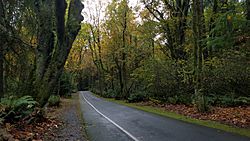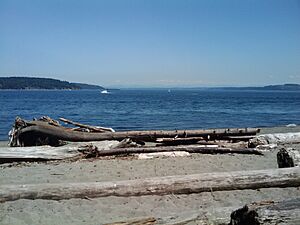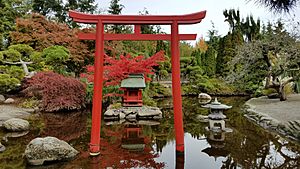Point Defiance Park facts for kids
Quick facts for kids Point Defiance Park |
|
|---|---|

Old growth forest along Five Mile Drive
|
|
| Lua error in Module:Location_map at line 420: attempt to index field 'wikibase' (a nil value). | |
| Location | 5400 N. Pearl St. Tacoma, Washington 98407 |
| Area | 760 acres (3.1 km2) |
| Operated by | Metropolitan Park District of Tacoma |
| Visitors | Over 3 million |
| Open | 30 minutes before sunrise to 30 minutes after sunset |
| Parking | Free |
Point Defiance Park is a huge park in Tacoma, Washington, USA. It covers about 760 acres (308 hectares). This amazing park has many cool things to see and do, like the Point Defiance Zoo & Aquarium, beautiful gardens, beaches, and lots of trails. You can also find a boardwalk, a boathouse, and a ferry dock that takes you to Vashon Island. The park is also home to Fort Nisqually, a special dog park, and a very old forest with giant trees. More than three million people visit Point Defiance Park every year! The Metropolitan Park District of Tacoma takes care of the park.
Contents
Discover Wildlife in the Park
Point Defiance Park is a fantastic place for both people and animals. You don't just see wild animals inside the Zoo & Aquarium!
Birds and Sea Animals
From the tall cliffs overlooking the Tacoma Narrows, you can watch bald eagles. They hunt for salmon swimming in the strong ocean currents. You might even hear their calls from their nests in the old-growth forest. This forest covers the northern 400 acres (162 hectares) of the park.
In winter, sea lions travel from California to feed in the swirling tides. You can often spot them near the Gig Harbor overlook at the very tip of the park. Harbor seals are also common here most of the year. In late summer and early fall, you might see seal pups near Owen Beach. Remember to keep your distance from these young seals and their parents!
Forest Animals
The park is also home to many other animals. You might see mule deer, red foxes, pileated woodpeckers, Douglas squirrels, and raccoons.
Endangered Species Help
One special part of the park is the Japanese Garden, a peaceful place to relax. At sunset, you might hear wolves howling as the sun sets behind the tall trees and the Olympic Mountains. These wolves are temporary guests. They are part of a project by the Zoo & Aquarium and Northwest Trek Wildlife Park to help endangered animals.
Fun Activities and Recreation
Point Defiance Park is the biggest urban park in Pierce County. It has many roads and trails that wind through the forest. These paths are perfect for joggers, cyclists, and hikers looking for a peaceful escape.
Trails and Drives
The trails are marked with symbols to help you find your way. Parts of the Five Mile Drive are closed to cars on Saturdays. This gives people more space to walk, run, or bike safely. Many hiking trails along the park's cliffs offer amazing views of Vashon Island, Dalco Passage, Gig Harbor, and the Tacoma Narrows Bridge. The road network also passes by Fort Nisqually.
Water Activities
From Owen Beach, kayakers can launch their boats and ride the strong currents. Fishermen also enjoy drifting in these tides, hoping to catch salmon. The tall 100-foot (30-meter) cliffs provide a quiet buffer from the city noise. Kayakers can find a peaceful spot in the middle of an urban area. Many people also enjoy spending time on the beaches.

Park History
Point Defiance Park started as a military area in the 1840s. This was after the Wilkes Expedition explored and mapped Puget Sound. Wilkes supposedly said that with a fort here and one across the narrows in Gig Harbor, one could "Defy" the world. However, the high cliffs and great location were never used for military battles.
Becoming a Public Park
In 1888, President Grover Cleveland allowed the land to be used as a public park. By 1890, streetcars brought visitors to explore the gardens. A waterfront building was finished in 1903. By 1907, a seaside resort designed by Frederick Heath offered warm saltwater baths. This building was called the Nereides Baths.
Fort Nisqually
Fort Nisqually is a copy of a trading post from the 1800s. It shows what the Hudson's Bay Company (an English trading company) was like in the region. This company had trading forts from the Columbia River all the way north to the Yukon River in what is now Alaska.
Today, Fort Nisqually hosts special events. Traders, trappers, and Native American tribes dress in old-fashioned clothes. They come back to the fort to act out what life was like long ago. They even travel by traditional cedar canoes!
Modern Connections
In 2019, Tacoma's soccer team changed its name to Tacoma Defiance, named after the park. Also in 2019, the park opened the Frank Herbert Trail and Dune Peninsula. This honors science fiction writer Frank Herbert, who was born in Tacoma and wrote the famous Dune novels.
Park Features
Beautiful Formal Gardens
The park's beautiful gardens are still here today. Visitors can explore the Japanese Garden, Rose Garden, and Dahlia gardens. These gardens surround the old superintendent's home, which was built in 1898. The gardens are near the main entrance of the park, close to the Zoo & Aquarium. They sit on a bluff overlooking the boathouse, a restaurant, and the ferry landing to Vashon Island. Other gardens in the park include the Native Plant, Herb, Fuchsia, and Iris gardens.
A main feature of the Japanese Garden is the Pagoda. It was built in 1914 as a streetcar station. When buses replaced streetcars in 1938, the Pagoda became a bus waiting area. In 1963, it was changed into a place for flower shows and parties. The Pagoda was fixed up in 1988. In 2011, it was badly damaged by a fire but was beautifully restored. The Pagoda is often rented for weddings and other events.
Boating Facilities
For many years, a company called ASARCO dumped waste into Puget Sound. This created a peninsula that now forms the park's protected harbor. The Tacoma Yacht Club is located on this peninsula. There is also a public boat launch at the harbor entrance, which is part of the park's fun activities.
Point Defiance Zoo & Aquarium
The park is home to the popular Point Defiance Zoo & Aquarium. It's a great place to learn about animals from all over the world.
Science and Math Institute
In 2009, Tacoma Public Schools opened the Science and Math Institute (SAMI) inside Point Defiance Park. SAMI is a special high school focused on science and math. Students at SAMI have classes on the beach, in the pagoda, in the forests, and at the Zoo. The school uses portable classrooms provided by Metro Parks. SAMI is similar to another special high school in the district, Tacoma School of the Arts (TSOTA).
Natural Landscapes and Activities
Besides the old-growth forest with 450-year-old Douglas fir trees, the park has 250-foot (76-meter) tall cliffs. These cliffs show off interesting rock layers. Groups and individuals often gather at the park for picnics, weddings, and special events. On Saturday and Sunday mornings, the outer loop of Five Mile Drive is closed to cars. This allows walkers and cyclists to enjoy the park's most popular area freely. The park also has an off-leash dog area. The Zoo & Aquarium is a paid attraction.
A Great American Place
The American Planning Association named Point Defiance Park a "2011 Great American Place." This means it's a very special and important place in the United States.
Community Involvement
People in Tacoma really wanted Point Defiance to be a park. In 1888, they asked President Grover Cleveland to change it from a military area to a park. In 1905, President Theodore Roosevelt signed a law giving the city full ownership of the park.
The park's first superintendent, Ebenezer Roberts, asked schoolchildren in 1895 to donate rose clippings. This helped start the rose garden! Today, the gardens have grown to include native plants, herbs, iris, dahlia, and fuchsia. Volunteers spend their time and donate plants to help keep the gardens beautiful.
In 2005, a citywide Park Bond Program provided $5.5 million to improve Point Defiance Park. This money helped restore the Pagoda, fix trails, clean up soil, and change mowed grass areas into natural habitats. More than 1,500 citizens have helped plan these park improvements since 2008.





